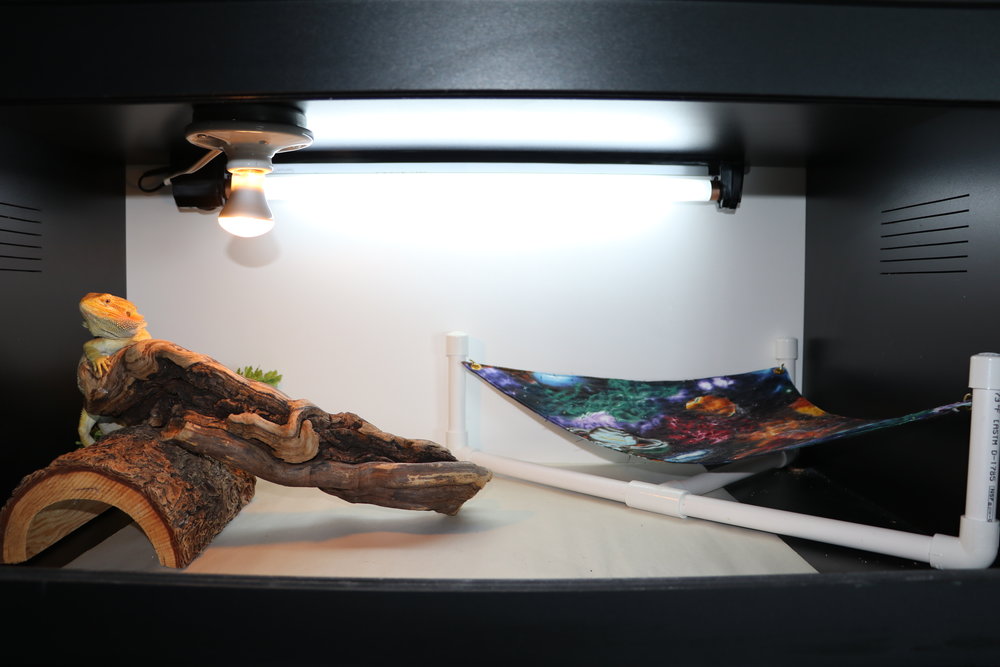HEAT & LIGHTING
HEAT for Bearded Dragons

Its very important for your beardie's immediate and longterm health to maintain a consistent heating gradient in their enclosure. You can reach ideal temperatures by trying different Watt heat bulbs and creating a basking area where they can climb up closer to the lamp. Their "basking spot" (the closest spot under the heat lamp) should be anywhere from 100-110 degrees Fahrenheit and there should be a cooler area on the other side of the tank that can be anywhere from 80-95 degrees.
If you are not getting the basking temps right, you should try different Watt bulbs ranging from 25w-150w. The strength of the bulb generally depends on the size of your tank and how much air circulation there is (e.g. top of tank is screen or closed top, ventilation on sides). Any basic thermometer can help you read the temps inside the terrarium but the most accurate are the temp guns, where you can point a laser at a certain spot and it reads the temperature very accurately.
Basking and Cool Zones For A Bearded Dragon
Providing your bearded dragon with different heat sources helps generate a gradient of temperatures throughout the beardie’s environment. This is important as, throughout the day, your new pet will require areas to bask in (a raised flat rock or branch will do) that need a direct, secondary heat source. Your bearded dragon also needs cool zones away from this direct heat and out of the light.
UVB LIGHTING for Bearded Dragons

Proper UVB lighting is a necessity for your beardie's longterm health. You can use any UVB bulb rated for desert reptiles for the duration of the day and turn them off at night (use a timer). They usually come in 18 and 24 inches and can be found at all major pet stores or online. The light and fixture should be placed in the center of the tank.
Pet bearded dragons receive light from three common sources: visible white light (through fluorescent or incandescent lamps), ultraviolet light and natural sunlight. Visible light sources produce heat and help you see your beardie. UVB and sunlight are vital to your lizard's survival. Beardies absorb the UVB rays of the sun to obtain essential vitamin D3, which these lizards use to absorb calcium and other essential nutrients. It's crucial that any UVB lights you buy your beardie are a full spectrum UVB light and not UBB. Also, if you're able to give your new pet direct sunlight, make sure that he or she still has some shady spots to hide and cool down. And, due to the greenhouse effect, it's important to know that sunlight and UV rays do not pass through glass enclosures.
Its also important for your beardie to have a place to hide from the light when it wants to cool down or rest. Common things to put in their tanks where they can take cover are hollow logs, plastic caves, hammocks, etc. Companies like Zilla, Zoo-Med, and many others make excellent, safe accessories for your beardies habitat.
Bearded Dragon Humidity
Aside from proper temperature and lights, bearded dragons also require the right level of humidity. The natural habitat for a bearded dragon is essentially the desert, so their bodies don't require a lot of water to survive. They'll get most of their daily water needs from food, but you should also make fresh drinking water available too. Don't be surprised if they treat their water bowl as a little soaking tub too. Humidity gets unusually low in the winter, and many bearded dragon owners keep a spray bottle full of water on hand to occasionally spritz their scaley companion. You can measure the humidity with a hygrometer.

